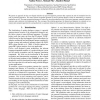Free Online Productivity Tools
i2Speak
i2Symbol
i2OCR
iTex2Img
iWeb2Print
iWeb2Shot
i2Type
iPdf2Split
iPdf2Merge
i2Bopomofo
i2Arabic
i2Style
i2Image
i2PDF
iLatex2Rtf
Sci2ools
LREC
2008
2008
CLIoS: Cross-lingual Induction of Speech Recognition Grammars
We present an approach for the cross-lingual induction of speech recognition grammars that separates the task of translation from the task of grammar generation. The source speech recognition grammar is used to generate phrases, which are translated by a common translation service. The target recognition grammar is induced by using the production rules of the source language, manually translated sentences and a statistical word alignment tool. The coverage of the resulting grammars (for Spanish and Japanese) is evaluated on two corpora and compared quantitatively and qualitatively to a grammar induced with unsupervised monolingual grammar induction.
Education | LREC 2008 | Speech Recognition Grammar | Target Recognition Grammar | Unsupervised Monolingual Grammar |
| Added | 29 Oct 2010 |
| Updated | 29 Oct 2010 |
| Type | Conference |
| Year | 2008 |
| Where | LREC |
| Authors | Nadine Perera, Michael Pitz, Manfred Pinkal |
Comments (0)

